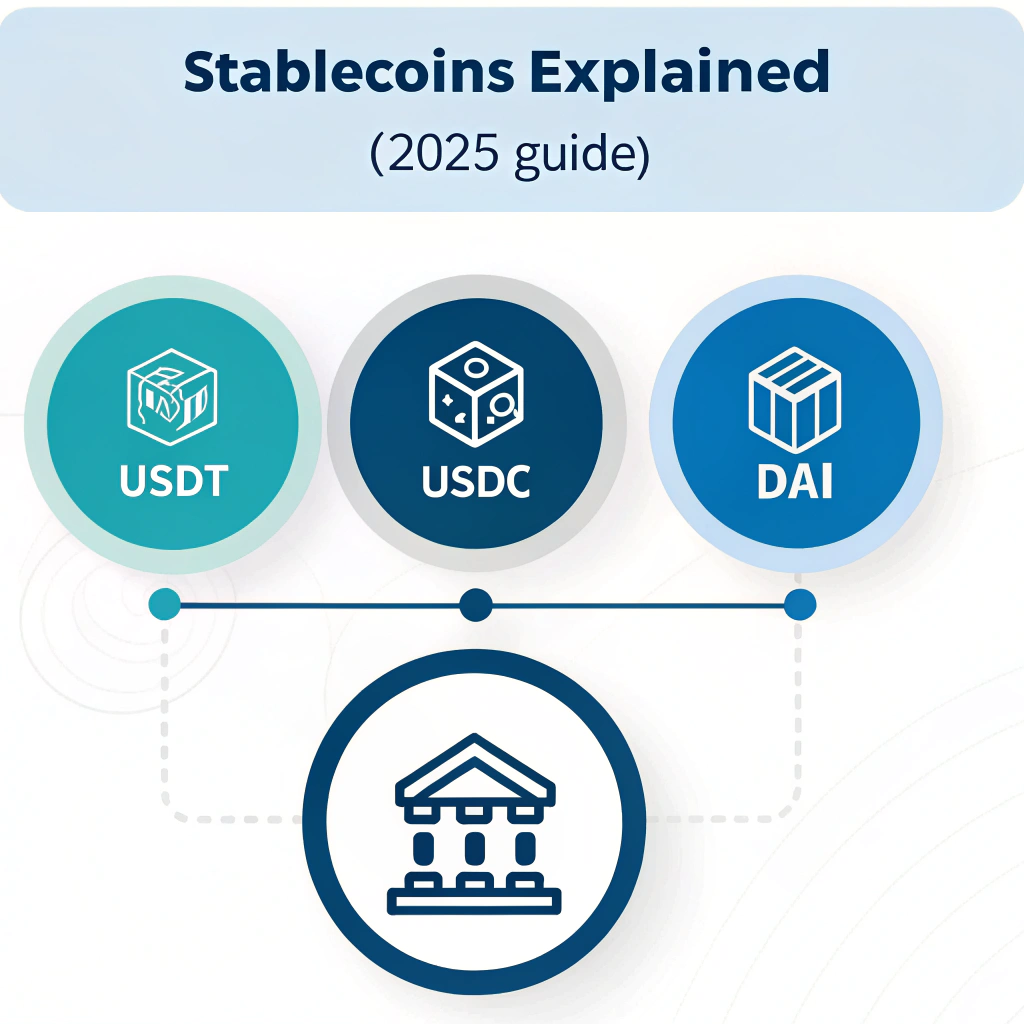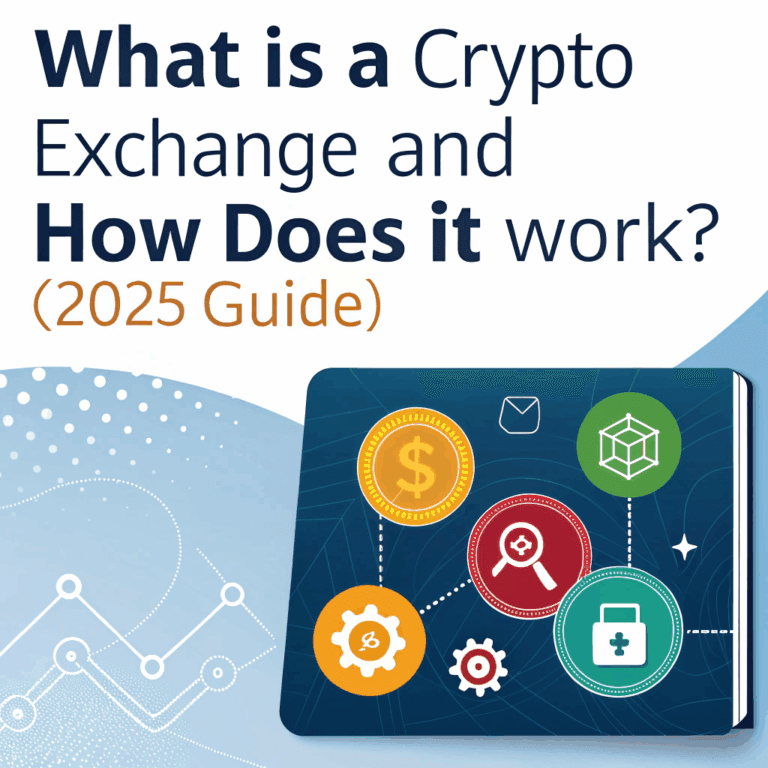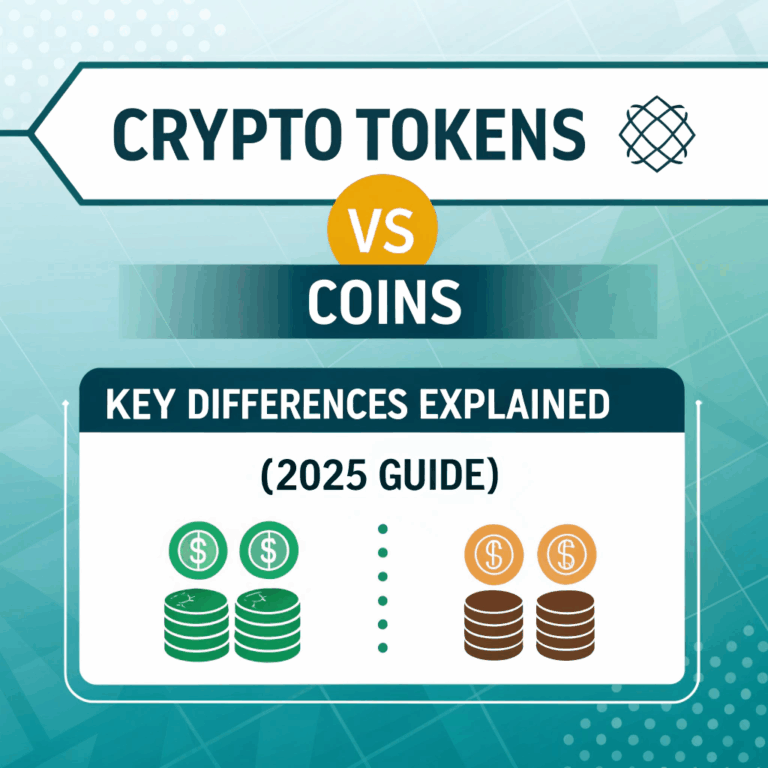What Are Stablecoins? USDT, USDC, DAI Explained (2025 Guide)

Introduction
In a world where crypto prices can swing wildly, stablecoins offer a safe haven. Pegged to stable assets like the US dollar, they give you the benefits of crypto — speed, borderless payments, DeFi access — without the volatility. In 2025, stablecoins are essential tools in the digital economy.
What is a Stablecoin?
A stablecoin is a type of cryptocurrency designed to maintain a stable value, typically pegged to a fiat currency like the US dollar (USD), Euro (EUR), or even gold.
- 1 USDT ≈ $1
- 1 USDC ≈ $1
- 1 DAI ≈ $1
They’re used to store value, trade, and interact with DeFi without exposure to wild price swings.
Why Stablecoins Matter in Crypto
- Provide stability during volatile markets
- Enable fast, cheap transfers
- Used as liquidity in DeFi protocols
- Allow crypto-to-crypto trading without needing fiat
- Can be held or spent globally 24/7
Stablecoins bridge the gap between the crypto world and traditional finance.
How Do Stablecoins Maintain Stability?
Stablecoins use various mechanisms to keep their value pegged:
- Fiat-backed: Each coin is backed by real-world dollars held in reserve (e.g., USDT, USDC)
- Crypto-backed: Backed by overcollateralized crypto like ETH (e.g., DAI)
- Algorithmic: Use supply/demand algorithms to stabilize price (less common in 2025 due to failures)
Types of Stablecoins
| Type | Backed By | Examples |
|---|---|---|
| Fiat-backed | USD in bank reserves | USDT, USDC |
| Crypto-backed | Other crypto (e.g. ETH) | DAI |
| Algorithmic | Supply algorithms | UST (collapsed), FRAX (still used) |
| Commodity-backed | Gold or other assets | PAXG (gold) |
Centralized vs. Decentralized Stablecoins
| Feature | Centralized (USDT, USDC) | Decentralized (DAI) |
|---|---|---|
| Issuer Control | Controlled by a company | Governed by smart contracts |
| Transparency | Varies (audits, reports) | Fully on-chain |
| Regulation | Easier to regulate | Harder to regulate |
| Risk | Regulatory freeze risk | Smart contract risk |
| Best For | Simple transfers, CEX use | DeFi, decentralization |
USDT (Tether) Explained
- Launched: 2014
- Issuer: Tether Limited
- Backing: Primarily USD and cash equivalents
- Use Cases: Most traded stablecoin; supported on nearly every platform
- Criticism: Questions about full backing and transparency
- Pros: High liquidity, widely accepted
- Cons: Centralized, less transparent than USDC
USDC (USD Coin) Explained
- Launched: 2018
- Issuer: Circle (U.S. company, fully regulated)
- Backing: 1:1 with U.S. dollars, audited regularly
- Use Cases: Preferred in U.S. DeFi and compliant platforms
- Pros: Regulated, transparent
- Cons: Still centralized and subject to U.S. regulation
DAI Explained
- Launched: 2017
- Issuer: MakerDAO (decentralized protocol)
- Backing: Overcollateralized crypto (ETH, USDC, others)
- Stability Mechanism: Smart contracts and governance tokens
- Use Cases: Decentralized finance (DeFi), lending platforms
- Pros: Censorship-resistant, decentralized
- Cons: Complex system, depends on volatile collateral
Pros and Cons of Stablecoins
Pros:
- Stable value
- Fast and low-cost transfers
- Useful for trading, saving, and lending
- Access to DeFi without volatility
- Easily programmable via smart contracts
Cons:
- Centralized coins can be frozen or censored
- Decentralized coins depend on collateral markets
- Not FDIC insured or backed by a government
- Still subject to legal and technical risk
Use Cases of Stablecoins in 2025
- Trading pair base on exchanges (BTC/USDT, ETH/USDC)
- Yield farming in DeFi protocols
- Cross-border payments in seconds
- Stable savings accounts with interest
- Payroll in crypto-native companies
- Remittances without currency conversion fees
Stablecoins and Regulation
In 2025, regulators are closely watching stablecoins due to their link to fiat currencies. Many governments are:
- Proposing stablecoin laws (e.g., U.S. Stablecoin Act)
- Requiring full reserve backing and audits
- Supporting Central Bank Digital Currencies (CBDCs) as competition
Some countries treat them like cash, others like securities.
Are Stablecoins Really Safe?
They’re safer than volatile cryptos — but not risk-free.
- USDT/USDC: Risk lies in regulation and trust in the issuer
- DAI: Risk lies in smart contract bugs and market conditions
- All stablecoins: Pegs can break under extreme stress
Use trusted platforms, check audit reports, and diversify when needed.
FAQ
Which stablecoin is best?
USDC is most transparent. DAI is best for DeFi. USDT has the most liquidity.
Can stablecoins lose their peg?
Yes — it has happened. But major stablecoins work hard to restore stability quickly.
Are stablecoins insured?
No. They’re not covered by deposit insurance like bank accounts.
Can I earn interest on stablecoins?
Yes, through lending platforms, staking, and savings protocols.
Conclusion
Stablecoins are essential tools in the crypto world — offering price stability, fast transactions, and access to DeFi. Whether you’re trading, saving, or sending money across borders, understanding the differences between USDT, USDC, and DAI helps you make smarter choices in 2025.





